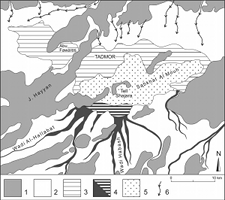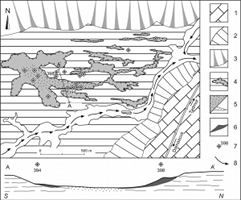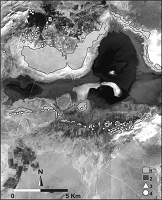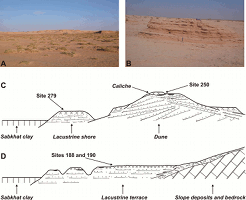Al-As'ad, W., Al-Maqdissi, M., Meyer, C.J. (Eds.), Studia Orontica,
2011
The prehistory of Palmyra (Tadmor, central
Syria): environmental changes and cultural dynamics between the
late Pleistocene and the early Holocene
Mauro Cremaschi, Andrea Zerboni, Michel Al-Maqdissi
Abstract
Evidence of late Pleistocene to early Holocene occupation of
the region surrounding the oasis of Palmyra/Tadmor (central Syria)
consists of geometric Kebaran, Natufian and early Neolithic archaeological
sites. These are distributed along the margin of the Sabkhat
al Mouh and in the Abu Fawares area, in connection with lacustrine
deposits, suggesting a period with a humid climate. Wet environmental
conditions presumably turned toward aridity in correspondence
with the early Neolithic, and later archaeological sites were
concentrated in the area of the present-day oasis and marginally
within the Abu Fawares basin.

|
Simplified geological sketch of the area surrounding Palmyra/Tadmor
(modified, Soulidi-Kondratiev, 1966). Key: 1) pre-Quaternary
bedrock outcrop; 2) Quaternary deposits; 3) Pleistocene lake
deposits; 4) delta system; 5) sabkhat; 6) erosional stream. |
|

|
Geomorphological sketch of Abu Fawares area, indicating the location
of Epipalaeolithic and Neolithic archaeological sites; a Geological
cross section is also reported. Key: 1) bedrock outcrop; 2) slope
deposits; 3) pediment; 4) wind-blown depression; 5) lake sediments;
6) archaeological mounds; 7) archaeological sites; 8) main wadis. |
|

|
Distribution of late Pleistocene/early Holocene aeolian and lacustrine
deposits in the sabkhat area; archaeological sites are also indicated
(dots). Key: 1, lacustrine terrace; 2, dune; 3, main sites (A,
Tell Site 288; B, wadi Aid section); 4, archaeological sites. |
|

|
(A) Late Pleistocene/early Holocene lacustrine terraces at the
southern margin of the sabkhat. (B) A gypsum-sand dune at the
southern margin of the sabkhat. Cross sections of the sand dunes
(C) and lacustrine terraces (D) at the southern margin of the
sabkhat. |
|

|
Stratigraphic section at wadi Aid. Black triangles indicate the
locations of flint artefacts (a, Geometric Kebaran; b, Mousterian);
the layer radiocarbon dated by Sakaguchi (1987) is also indicated. |
|
|

